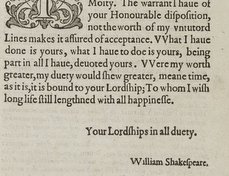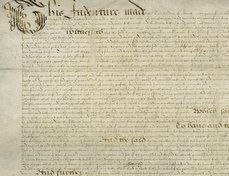Reproduced by permission of Shakespeare Birthplace Trust
Terms of use
The Shakespeare Birthplace Trust has graciously contributed images under a Creative Commons Attribution NonCommerical ShareAlike 4.0 International license. Visitors may download, link to and cite the images for personal research only. Any further use, including, but not limited to, unauthorized downloading or distribution of the images, commercial or third party use, is strictly prohibited. Visitors must contact the Shakespeare Birthplace Trust to request additional use, at: images.scla@shakespeare.org.uk
Document-specific information
Date: October 2, 1652
Repository: The Shakespeare Birthplace Trust, Stratford-upon-Avon, UK
Call number and opening: TR46/2/16
Robert Bearman, "Elizabeth Barnard (formerly Nash) joins with her second husband John Barnard in a new settlement of the Shakespeare family estates: the beneficiaries’ copy," Shakespeare Documented, https://doi.org/10.37078/569.
Shakespeare Birthplace Trust, TR46/2/16. See Shakespeare Documented, https://doi.org/10.37078/569.
Following the death of her first husband, Thomas Nash in 1647, Elizabeth Hall Nash, Shakespeare’s granddaughter, married John Barnard of Abington, near Northampton, on June 5, 1649. A month later, her mother Susanna also died. Doubts on the future of the Shakespeare family estates had already arisen under the terms of her first husband’s will, which had led to the drawing up of a new settlement to protect her interests, followed by a legal action which had still not been resolved. Elizabeth therefore felt it advisable to draw up a new settlement to take her new circumstances into account.
By a fine of 1650, her second husband, John Barnard, was appointed one of the trustees of the 1647 settlement and then, on October 2, 1652, a new settlement was drawn up, shown here. This ensured that the family estates (now limited to New Place, and four and a half yardlands in Old Stratford, Bishopton and Welcombe, described as “heretofore The inheritance of William Shakespeare, gentleman, grandfather of the said Elizabeth wife of the said John Barnard,” should be held by trustees, Henry Smith and William Fetherston, to the use of John Barnard and his wife Elizabeth for their lives. After their deaths the estates were to revert to any children Elizabeth might bear (though she was already forty-four) or in default “to the use of such person or persons … as the said Elizabeth by any writeing either purporteing her last will or otherwise ... shall lymitt and appoint.” This was a significant variation in the terms of the entail under Shakespeare’s will, which had limited the descent of his property by primogeniture to the descendants of his children, or in ultimate default, to his “right heirs.” If Elizabeth’s died without issue, Shakespeare’s “right heirs” could have been taken to be the descendants of his sister Joan Hart. On the other hand, the fact that the old family homestead in Henley Street, now partly occupied by the Hart family, was excluded from the settled estates suggests that Elizabeth already had it in mind to leave it to them – as by her will she eventually did. The settlement was further buttressed by a deed poll under Elizabeth Barnard’s hand of April 16, 1653.
The settlement survives in two copies and both were originally filed with the title deeds relating to the family estates. The copy, shown here, signed by the trustees, “Henry Smith” and “William ffetherston,” eventually passed with other deeds into the care of the Shakespeare Birthplace Trust on its acquisition of New Place. The current location of the other copy signed by “John Barnard” and “Eliza. Barnard,” is unknown.
Written by Robert Bearman
Last updated July 24, 2023



















